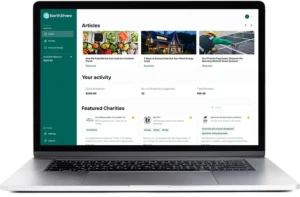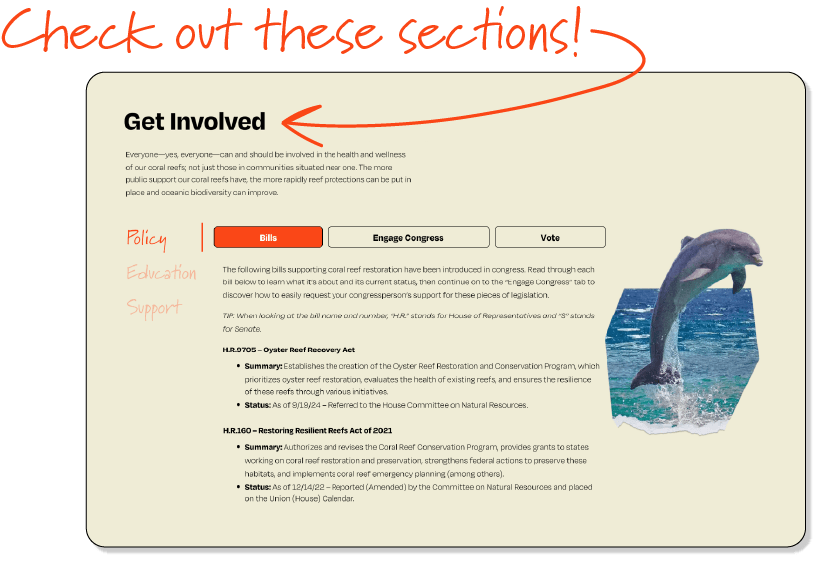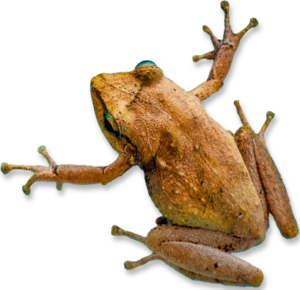SOLUTION
Sustainable Fisheries
Achieving 30×30 by addressing how we fish
Created in partnership with
Wild Salmon Center
What is sustainable fishing?
Sustainable fishing is the implementation of fishing practices that ensure healthy streams, rivers, lakes, and oceans, as well as healthy and diverse fish and wildlife populations long into the future.
This includes sustainable aquaculture, well-managed fisheries, and adapting human behaviors to respect and support balanced aquatic ecosystems.
“For [migrating] species like salmon—whose lifecycles span both marine and inland environments—the protection of upriver habitat and sustainable fishing are both crucial to their success… And, in turn, leads to healthier forests, robust food webs, and cleaner, colder water.”
– Kim Kosa, Wild Salmon Center
Traditional Indigenous Knowledge
For tens of thousands of years, humans have sustainably harvested fish for both food and commerce. Examples of Indigenous Peoples in the northern Pacific Rim harvesting salmon for sustenance date back more than 10,000 years. To this day, Indigenous communities fish with intentionality, using fish and resource management practices to balance human needs alongside healthy fish populations and ecosystems.1“Indigenous Systems of Management for Culturally and Ecologically Resilient Pacific Salmon Fisheries,” Bioscience ≫
Unfortunately, the rise of industrial commercial fishing pushed aside these traditional practices until sustainable fishing became the outlier, not the norm. As we navigate toward a future that once again prioritizes sustainable fishing, we must acknowledge the originators and keepers of this traditional knowledge and uplift Indigenous communities as subject experts and leaders.2“Indigenous Fishing Practices Hold Promise for Future,” Wild Salmon Center ≫
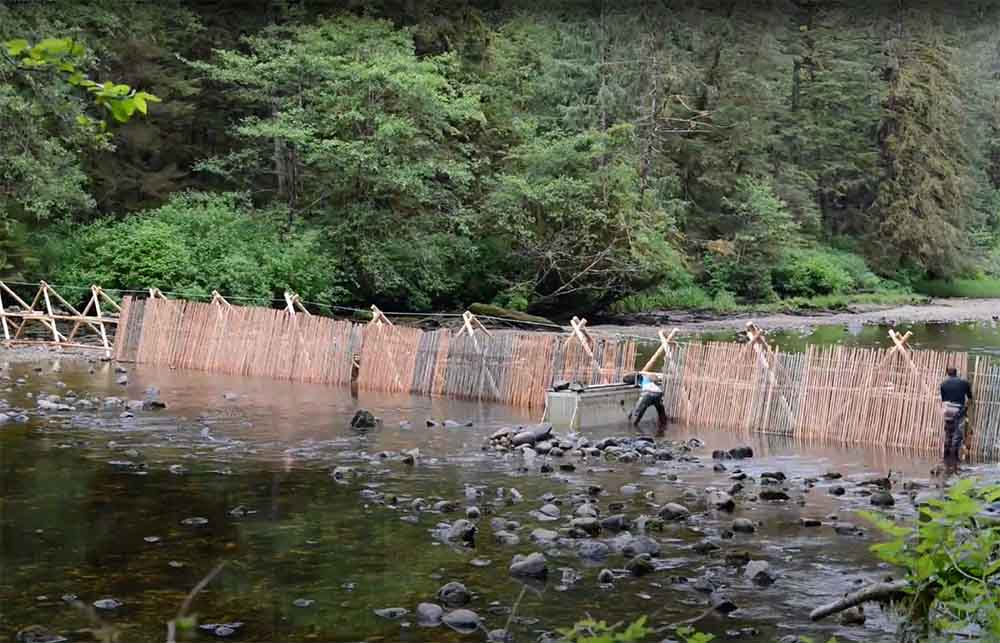
Learn about Indigenous fishing practices within the Heiltsuk First Nation community of coastal British Columbia. (VIDEO: Natural Sciences and Engineering Research Council of Canada/YouTube)
Sustainable Fishing and 30x30
Healthy fresh and marine waters require thriving fish populations to maintain balanced ecosystems. Why are balanced, aquatic ecosystems important? For starters, many countries and cultures around the world rely heavily on fish for both sustenance and income. It’s estimated that humans catch or consume 200 million tons of fish every year, equal to a total number of fish somewhere in the trillions. Fish, both freshwater and marine, are integral to food security worldwide, which makes protecting fish populations and their ecosystems even more important.3“Fish and Overfishing,” Our World in Data ≫; “Two-Thirds of the World’s Seafood Is Over-Fished,” Forbes ≫
Sustainable Fishing and Climate Change
Our planet’s waters are a huge carbon sink. Oceans alone absorb more than 30% of all human-produced carbon and roughly 90% of the heat created by these emissions. Rivers, streams, and lakes are also major carbon holders. So much so that, due to human activity and the destruction of forests and other carbon-holding environments, lakes have tripled the amount of carbon they bury in the sediment beneath them.4“Quantifying the Ocean Carbon Sink,” NOAA ≫; “The ocean – the world’s greatest ally against climate change,” United Nations ≫; “New study finds lakes have tripled the amount of carbon they bury,” Loughborough University ≫
The increased carbon level in our waters, as well as increasing water temperatures due to climate change—a result of excess heat absorption and human interference in natural habitats (e.g., dams, logging, and overfishing)—are wreaking havoc on ecosystems worldwide. Changing water temperatures dramatically impact fish reproduction and spawning grounds, and increased carbon levels in the water result in acidification, harming many aquatic species.
Sustainable Fisheries: The Low Down
Learn about the who, where, and when of how we can leverage sustainable fishing for 30×30 goals.
- The Who
- The Where
- The When
Who has the power to initiate the greatest change when it comes to fishing and fisheries? Like with any environmental solution, there are many factors at play. However, to successfully address this question, we need to consider who has the power to make the greatest sweeping changes in policy, funding, and fishing industry practices.
Here are the groups that can help the most:
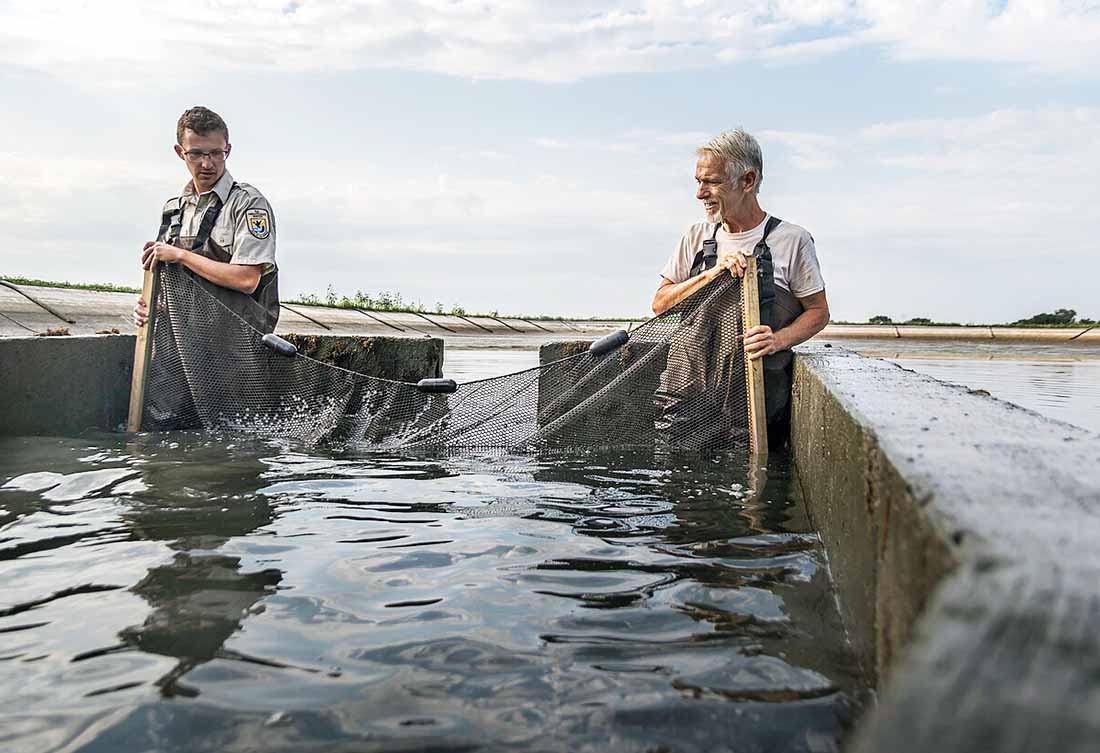
Staff harvest paddlefish from a rearing pond at the Gavins Point National Hatchery near Yankton, South Dakota. (IMAGE: Sam Stukel/U.S. Fish & Wildlife Service/Wikimedia Commons)
More than 70% of our planet is covered in water, which means there are a lot of places where we could focus our efforts on sustainable fishing. Certainly, an overwhelming prospect, but one that can be tackled by prioritizing those areas where human influence is most significant as well as important ecological regions where improvements to fishing practices will promote faster recovery.
EXISTING FISHERIES | It may not seem like fisheries and land conservation have much to do with one another, but this could not be further from the truth. Addressing how we protect and manage our existing wild fisheries can have beneficial outcomes for fish populations, other wildlife, food supply, and even our lands and forests. Initiating protections against harmful practices, such as mining and industrialization near important fish habitats, as well as introducing and actively managing for improved standards in sustainable fishing will play a large role in protecting the health and wellbeing of critical fresh and marine waters while simultaneously increasing livelihood prospects for fishers. Migrating salmon also fertilize trees and help with forest growth!5“Can shrimp farming restore mangroves?” Conservation International ≫; “Bristol Bay,” Wild Salmon Center ≫; “Effects of Salmon-Derived Nitrogen on Riparian Forest Growth and Implications for Stream Productivity,” Ecology ≫
FRESHWATER ECOSYSTEMS | Roughly 40% of fish caught for human consumption come from bodies of freshwater. When you consider the fact that freshwater only covers about 0.3% of the Earth’s surface, that forty percent begins to look a lot bigger.6“Sustainable Fishing,” National Geographic ≫
In tandem with other harmful drivers of global declines in freshwater biodiversity such as dams and other human-made industrial changes to watershed regions, it probably won’t come as a surprise that nearly one-third of all freshwater fish species are under the threat of extinction. Increasing freshwater fish populations isn’t just an ecological need either, it’s also a cultural one. Fish have been an integral part of human life for millennia. Addressing the health and wellness of our freshwater ecosystems is a critical step for the environment and for people to thrive.7“One-third of freshwater fish face extinction and other freshwater fish facts,” World Wildlife Fund ≫; “Early Humans May Have Cooked Fish 780,000 Years Ago,” Smithsonian Magazine ≫
NO-TAKE ZONES | A No-Take Zone is a stricter form of a marine protected area that, as the name suggests, disallows the fishing or procurement of sea life. These restrictions can be implemented at the local, territorial, tribal, state, and federal levels and can be strategically used in geographical areas that are ecologically important for species that are suffering. These protected areas can provide increased fishing opportunities in surrounding areas by protecting abundant, large, breeding-age individuals. Additional protections have been established in breeding grounds and nurseries and migration route waypoints. Qualifying freshwater habitats can also be given MPA status.8“Assessing spillover from marine protected areas and its drivers,” Di Lorenzo, Guidetti, Di Franco, Calò, Claudet; Fish and Fisheries, 2020 Sept. 21(5):906-15.
The good news is that sustainable fishing practices have been and continue to be used in many places around the world. In fact, many traditional techniques original to Indigenous communities (and still deployed for supporting everyday life) are now common practice for artisanal fishing, which employs 90% of the capture fisheries workforce worldwide (though this share is much smaller in North America). However, to have the positive impact needed, these practices need to be adopted on a broader scale and at a more rapid rate. Challenging, sure, but not impossible.9“Sustainable salmon fishing the Lummi way,” Seattle Times ≫; “Supporting Small-Scale Fisheries,” Sustainable Fisheries Partnership ≫
A 2016 report published in the Proceedings of the National Academy of Sciences estimates that, with proper reforms and management, global fish stocks can be at healthy levels again in just 10 years’ time AND will increase profits for fishers by 204% in the next three decades. Positive change is possible if we start now.10“Global fishery prospects under contrasting management regimes,” Proceedings of the National Academy of Sciences ≫
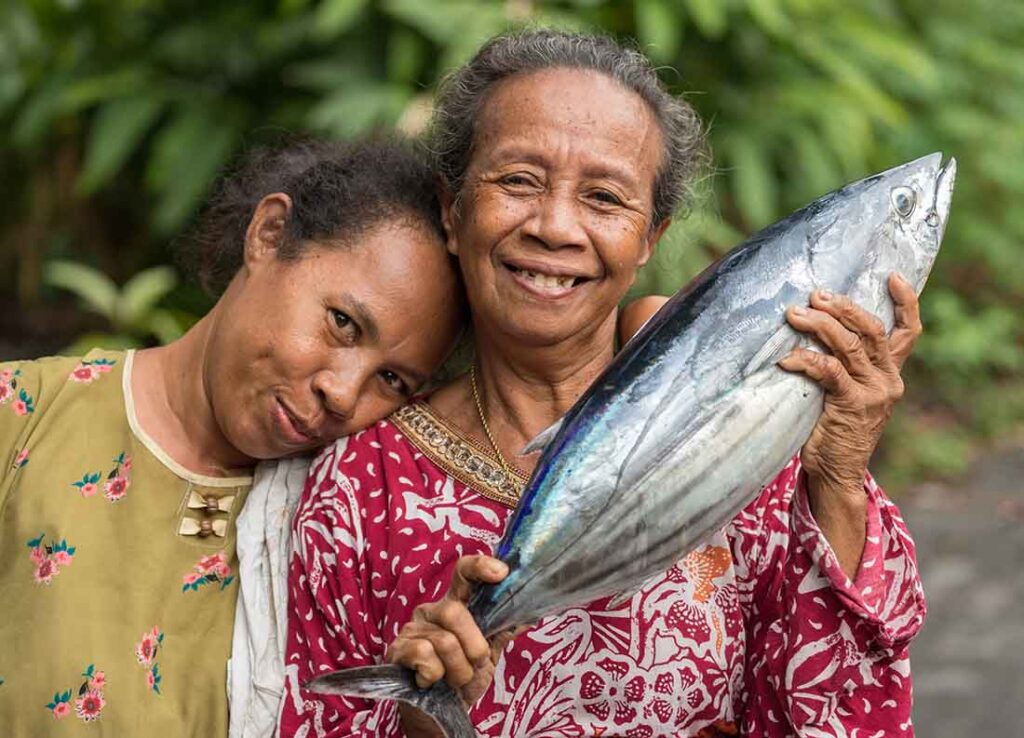
Residents from a coastal community on the island of Banda Neira in Indonesia hold a freshly-caught skipjack tuna. (IMAGE: USAID/Flickr)
Get Involved
EVERYONE can help expand sustainable fishing practices, and strong public support is one of the fastest ways to set change in motion, especially in the face of significant obstacles created by rapidly changing federal policy.
Explore below to learn more!
- Policy
- Education
- Support
- Bills
- Engage Congress
- Vote
The following bills supporting open spaces have been introduced in congress. Read through each bill below to learn what it’s about and its current status, then continue on to the “Engage Congress” tab to discover how to easily request your congressperson’s support for these pieces of legislation. (When looking at the bill name and number, “H.R.” stands for House of Representatives and “S” stands for Senate.)
H.R.8862 – Sustaining America’s Fisheries for the Future Act of 2024
- SUMMARY: This bill amends the Magnuson-Stevens Fishery Conservation and Management Act to better protect marine habitats and ecosystem stability, and to promote climate resilience.
- STATUS: As of 6/27/2024 – Introduced in the House and referred to the Committees on Natural Resources and Agriculture.
H.R.8788 – Fisheries Improvement and Seafood Health Act of 2024
- SUMMARY: This bill creates the Fisheries and Ecological Resilience Program to advance ocean understanding, assess impacts of human action, and develop new tools.
- STATUS: As of 6/18/2024 – Introduced in House and referred to the Subcommittees of Natural Resources and Ways and Means.
S.1484 – Forage Fish Conservation Act of 2021
- SUMMARY: This bill improves the management of forage fish for better whole ecosystem and food chain balance in aquatic settings.
- STATUS: As of 4/29/2021 – Read twice and referred to the Committee on Commerce, Science, and Transportation.
- SUMMARY: Amends the Endangered Species Act to enable the Fish and Wildlife Services (FWS) to protect and enforce regulations for anadromous and catadromous fish species.
- STATUS: As of 2/21/2023 – Referred to the Subcommittee on Water, Wildlife, and Fisheries.
Not sure who represents you in congress? Follow these quick steps to find your congressional representatives and how to contact them:
- Click here and input your home address, then click the search icon.
- Under the name of the representative you want to reach, look for the section titled “Contact.”
- To make a phone call, copy the phone number provided.
- To send an email (or other form of outreach), select the blue hyperlinked word “contact.”
- This will take you to a page with different methods for reaching your representative.
Your vote means something. It’s your chance to voice your support for the people and policies you think will make a positive difference in your community and across the country.
Register to Vote
Not yet registered to vote? Get started:
It’s super easy! All you have to do is:
- Select the state or territory you live in
- Start your online voter registration
When registering, make sure you have a valid form of identification. This could be your Driver’s License, State ID, and/or Social Security Number.
Find Your Voting Location
Are you a new voter? Have you moved recently? Or maybe you just want to double check you know where you’re going? Find your voting location:
Remind Others to Vote
- Text election reminders to friends and family
- Snap that “I Voted” selfie and share it with the world (this simple act has been shown to increase voter turnout by 4.1%)
- Help others create a voting plan
- Sign up for programs like When We All Vote to help educate others on the importance of voting, important deadlines, and more

- The Issues
- Advocate
- Keep Learning
Education is the first step in building public support for sustainable fishing and fisheries. Humans catch around 200 million tons of fish every year, which means the total number of individual fish we’re catching likely amounts to a number in the trillions.
Without protections and sustainable management practices in place, we will deplete our oceans of this important food source for billions of humans—it’s just a matter of when. Unfortunately, there is a popular misconception among the public that, despite these statistics proving otherwise, we can’t possibly overfish our seas. To communicate the importance of sustainable fishing, we must first break through this false narrative, and that’s where education comes into play.
The more people know about the harmful effects of many of today’s most common fishing practices and the true reality of today’s declining ocean stocks and habitats, the better equipped they are to make educated decisions on where they purchase their seafood and from whom. Education also needs to be happening at the legislative level. Lawmakers with the power to support new and existing legislation should have a firm grasp of these basic concepts.
Share This Page
Help educate your network of friends, family and followers when you share this page and post about it on social media!
Explore Further
Interested in learning even more about the importance of sustainable agriculture for the protection and wellbeing of our environment? We’ve compiled a list of key resources to help you move forward on your learning path.
Experts
Meet the professionals fighting for sustainable fishing and fisheries.
- Wild Salmon Center
- Conservation Law Foundation
- Environmental Defense Fund
- Environmental Law Institute
- Oceana
- Marine Stewardship Council
- Columbia River Inter-Tribal Fish Commission
Learning Hubs
- Faces of Sustainable Seafood | NOAA Fisheries
- Sustainable Fisheries | NOAA Fisheries
- Seafood Sustainability | World Wildlife Fund
- Sustainable Fisheries | MarineBio
Other Resources
- Seafood Guides | Monterey Bay Aquarium Seafood Watch
- Sustainable Fish Buying Guide | NRDC
- Find Sustainable Seafood Near You | Local Catch Network
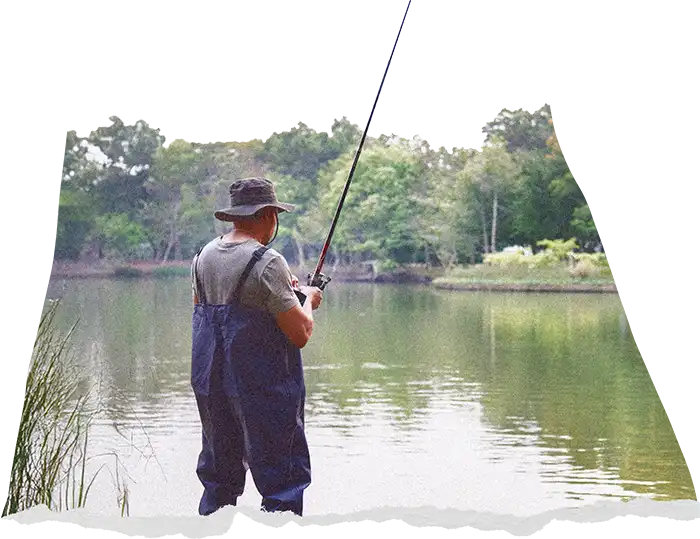
- Nonprofit Limitations
- Donate
- Volunteer
Ask any nonprofit in America (and around the world) what their greatest two challenges are, and they are very likely to say the same things: funding and capacity.
Nonprofits striving to implement and advance sustainable fishing and fisheries practices throughout the U.S. and around the globe are no stranger to this. That’s why your support—be it financial or through volunteer work—makes an enormous difference. By supporting an organization with your time and/or money, you are helping to increase their impact, expand their reach, and make it easier for good to be done for our planet.
Donate to Nonprofits
Meet the vetted EarthShare Nonprofit Partners making a difference for sustainable fishing and donate to their cause!
- Wild Salmon Center | Building protections for critical wild salmon fisheries throughout the North Pacific
- American Rivers | Removing dams and restoring rivers to benefit natural habitats and fish populations across America
- Conservation Law Foundation | Pushing for science-based fisheries management and accountability throughout the northeastern U.S.
- Ecology Center | Helping to identify toxic PFAS chemicals in the Great Lakes harming fishing, recreation, and human health
- Environmental Defense Fund | Empowering fishing communities worldwide to lead in sustainability via policy, tech, and financing
- Environmental Law Institute | Developing policy and legal frameworks to support sustainable management of global fisheries
- Ocean Conservancy | Working with U.S. decision-makers and others around the world to find sustainable fisheries solutions
- Oceana | Campaigning to stop overfishing and to increase the number of fisheries management plans globally
- Oyster Recovery Partnership | Supporting the sustainable growth and harvest of oysters and shellfish throughout Chesapeake Bay
- Potomac Riverkeeper Network | Improving mussel and fish populations in the Potomac River area through propagation assistance
- The Nature Conservancy | Restoring fish populations and habitats to help rebuild critical Great Lakes fisheries and food supply
- World Wildlife Fund | Researching and developing educational resources and guides for sustainable fishing and fisheries
Attend Events & Volunteer
Check out events and volunteer opportunities happening online, across the country, and near you.
- Wild Salmon Center | Volunteer | International
- Conservation Law Foundation | Volunteer | Massachusetts
- Ecology Center | Events | Michigan
- Environmental Defense Fund | Volunteer | International
- Environmental Law Institute | Events | National
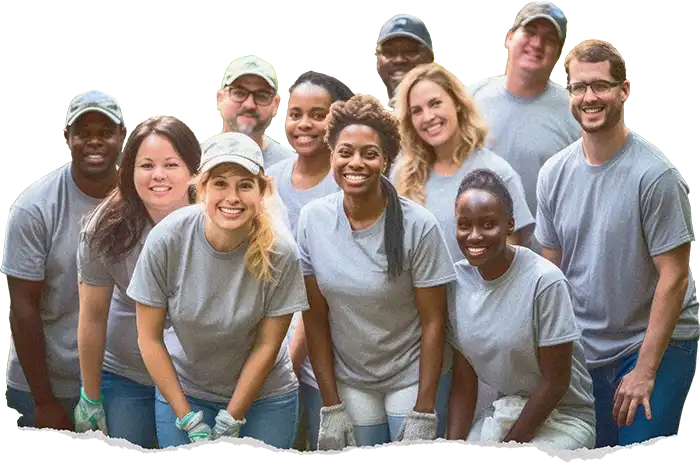
- Policy
- Education
- Support
- Bills
- Engage Congress
- Vote
The following bills supporting open spaces have been introduced in congress. Read through each bill below to learn what it’s about and its current status, then continue on to the “Engage Congress” tab to discover how to easily request your congressperson’s support for these pieces of legislation. (When looking at the bill name and number, “H.R.” stands for House of Representatives and “S” stands for Senate.)
H.R.8862 – Sustaining America’s Fisheries for the Future Act of 2024
- SUMMARY: This bill amends the Magnuson-Stevens Fishery Conservation and Management Act to better protect marine habitats and ecosystem stability, and to promote climate resilience.
- STATUS: As of 6/27/2024 – Introduced in the House and referred to the Committees on Natural Resources and Agriculture.
H.R.8788 – Fisheries Improvement and Seafood Health Act of 2024
- SUMMARY: This bill creates the Fisheries and Ecological Resilience Program to advance ocean understanding, assess impacts of human action, and develop new tools.
- STATUS: As of 6/18/2024 – Introduced in House and referred to the Subcommittees of Natural Resources and Ways and Means.
S.1484 – Forage Fish Conservation Act of 2021
- SUMMARY: This bill improves the management of forage fish for better whole ecosystem and food chain balance in aquatic settings.
- STATUS: As of 4/29/2021 – Read twice and referred to the Committee on Commerce, Science, and Transportation.
- SUMMARY: Amends the Endangered Species Act to enable the Fish and Wildlife Services (FWS) to protect and enforce regulations for anadromous and catadromous fish species.
- STATUS: As of 2/21/2023 – Referred to the Subcommittee on Water, Wildlife, and Fisheries.
Not sure who represents you in congress? Follow these quick steps to find your congressional representatives and how to contact them:
- Click here and input your home address, then click the search icon.
- Under the name of the representative you want to reach, look for the section titled “Contact.”
- To make a phone call, copy the phone number provided.
- To send an email (or other form of outreach), select the blue hyperlinked word “contact.”
- This will take you to a page with different methods for reaching your representative.
Your vote means something. It’s your chance to voice your support for the people and policies you think will make a positive difference in your community and across the country.
Register to Vote
Not yet registered to vote? Get started:
It’s super easy! All you have to do is:
- Select the state or territory you live in
- Start your online voter registration
When registering, make sure you have a valid form of identification. This could be your Driver’s License, State ID, and/or Social Security Number.
Find Your Voting Location
Are you a new voter? Have you moved recently? Or maybe you just want to double check you know where you’re going? Find your voting location:
Remind Others to Vote
- Text election reminders to friends and family
- Snap that “I Voted” selfie and share it with the world (this simple act has been shown to increase voter turnout by 4.1%)
- Help others create a voting plan
- Sign up for programs like When We All Vote to help educate others on the importance of voting, important deadlines, and more

- The Issues
- Advocate
- Keep Learning
Education is the first step in building public support for sustainable fishing and fisheries. Humans catch around 200 million tons of fish every year, which means the total number of individual fish we’re catching likely amounts to a number in the trillions.
Without protections and sustainable management practices in place, we will deplete our oceans of this important food source for billions of humans—it’s just a matter of when. Unfortunately, there is a popular misconception among the public that, despite these statistics proving otherwise, we can’t possibly overfish our seas. To communicate the importance of sustainable fishing, we must first break through this false narrative, and that’s where education comes into play.
The more people know about the harmful effects of many of today’s most common fishing practices and the true reality of today’s declining ocean stocks and habitats, the better equipped they are to make educated decisions on where they purchase their seafood and from whom. Education also needs to be happening at the legislative level. Lawmakers with the power to support new and existing legislation should have a firm grasp of these basic concepts.
Share This Page
Help educate your network of friends, family and followers when you share this page and post about it on social media!
Explore Further
Interested in learning even more about the importance of sustainable agriculture for the protection and wellbeing of our environment? We’ve compiled a list of key resources to help you move forward on your learning path.
Experts
Meet the professionals fighting for sustainable fishing and fisheries.
- Wild Salmon Center
- Conservation Law Foundation
- Environmental Defense Fund
- Environmental Law Institute
- Oceana
- Marine Stewardship Council
- Columbia River Inter-Tribal Fish Commission
Learning Hubs
- Faces of Sustainable Seafood | NOAA Fisheries
- Sustainable Fisheries | NOAA Fisheries
- Seafood Sustainability | World Wildlife Fund
- Sustainable Fisheries | MarineBio
Other Resources
- Seafood Guides | Monterey Bay Aquarium Seafood Watch
- Sustainable Fish Buying Guide | NRDC
- Find Sustainable Seafood Near You | Local Catch Network

- Nonprofit Limitations
- Donate
- Volunteer
Ask any nonprofit in America (and around the world) what their greatest two challenges are, and they are very likely to say the same things: funding and capacity.
Nonprofits striving to implement and advance sustainable fishing and fisheries practices throughout the U.S. and around the globe are no stranger to this. That’s why your support—be it financial or through volunteer work—makes an enormous difference. By supporting an organization with your time and/or money, you are helping to increase their impact, expand their reach, and make it easier for good to be done for our planet.
Donate to Nonprofits
Meet the vetted EarthShare Nonprofit Partners making a difference for sustainable fishing and donate to their cause!
- Wild Salmon Center | Building protections for critical wild salmon fisheries throughout the North Pacific
- American Rivers | Removing dams and restoring rivers to benefit natural habitats and fish populations across America
- Conservation Law Foundation | Pushing for science-based fisheries management and accountability throughout the northeastern U.S.
- Ecology Center | Helping to identify toxic PFAS chemicals in the Great Lakes harming fishing, recreation, and human health
- Environmental Defense Fund | Empowering fishing communities worldwide to lead in sustainability via policy, tech, and financing
- Environmental Law Institute | Developing policy and legal frameworks to support sustainable management of global fisheries
- Ocean Conservancy | Working with U.S. decision-makers and others around the world to find sustainable fisheries solutions
- Oceana | Campaigning to stop overfishing and to increase the number of fisheries management plans globally
- Oyster Recovery Partnership | Supporting the sustainable growth and harvest of oysters and shellfish throughout Chesapeake Bay
- Potomac Riverkeeper Network | Improving mussel and fish populations in the Potomac River area through propagation assistance
- The Nature Conservancy | Restoring fish populations and habitats to help rebuild critical Great Lakes fisheries and food supply
- World Wildlife Fund | Researching and developing educational resources and guides for sustainable fishing and fisheries
Attend Events & Volunteer
Check out events and volunteer opportunities happening online, across the country, and near you.
- Wild Salmon Center | Volunteer | International
- Conservation Law Foundation | Volunteer | Massachusetts
- Ecology Center | Events | Michigan
- Environmental Defense Fund | Volunteer | International
- Environmental Law Institute | Events | National

Where to Start
We’ve curated a list of nonprofits doing work with sustainable fisheries in the United States and around the world. Learn more about the incredible work they’re doing and show your support.
Check out these orgs!
Wild Salmon Center*Wild Salmon Center is our 30×30 Partner for forest restoration and contributed their knowledge, experiences, and on-the-ground expertise to improve accuracy and storytelling. | Building protections for critical wild salmon fisheries throughout the North Pacific
American Rivers | Removing dams and restoring rivers to benefit natural habitats and fish populations across America
Conservation Law Foundation | Pushing for science-based fisheries management and accountability throughout the northeastern U.S.
Ecology Center | Helping to identify toxic PFAS chemicals in the Great Lakes harming fishing, recreation, and human health
Environmental Defense Fund | Empowering fishing communities worldwide to lead in sustainability via policy, tech, and financing
Environmental Law Institute | Developing policy and legal frameworks to support sustainable management of global fisheries
Ocean Conservancy | Working with U.S. decision-makers and others around the world to find sustainable fisheries solutions
Oceana | Campaigning to stop overfishing and to increase the number of fisheries management plans globally
Oyster Recovery Partnership | Supporting the sustainable growth and harvest of oysters and shellfish throughout Chesapeake Bay
Potomac Riverkeeper Network | Improving mussel and fish populations in the Potomac River area through propagation assistance
The Nature Conservancy | Restoring fish populations and habitats to help rebuild critical Great Lakes fisheries and food supply
World Wildlife Fund | Researching and developing educational resources and guides for sustainable fishing and fisheries
* EARTHSHARE 30×30 PARTNER
Created as part of the Mosaic 2023 Movement Infrastructure grant program
Share your thoughts on The 30×30 Project website
©2025 EarthShare. All rights reserved. EarthShare is a registered 501(c)(3) nonprofit.
